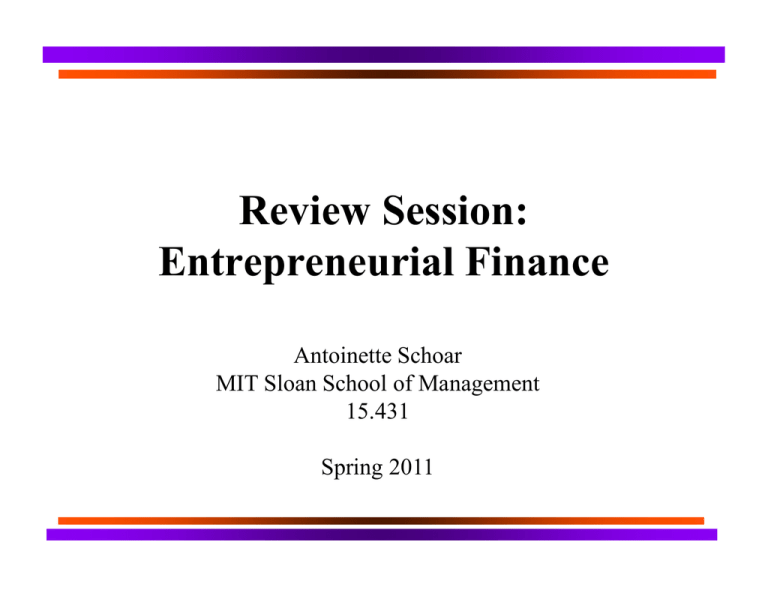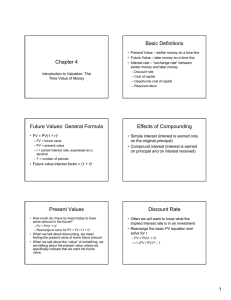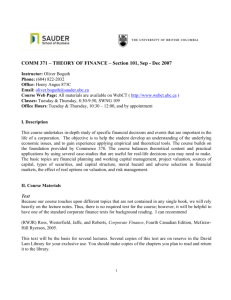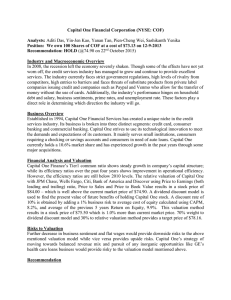Document 13448146
advertisement

Review Session: Entrepreneurial Finance Antoinette Schoar MIT Sloan School of Management 15.431 Spring 2011 Four major parts to the course: • • • • New venture valuation Deal structure Private equity partnership structure and incentives Exiting from private equity investments 2 Evaluating a business plan/opportunity: • Very difficult in entrepreneurial situations • Does not mean you shouldn’t do it • Valuation is as good as its assumptions • We looked at three methods: → Discounted cash flow (APV) method → VC method → Real options 3 Discounted cash flow method (APV) • Economics of business →Where does positive NPV come from? →Most important • Cash flows →Free cash flow to all equity investment = EBIT * ( 1 - t ) + DEPR - CAPX - Δ NWC • Discount rate →Economics + Cash Flows + Rate = VALUE 4 APV Approach for New Ventures • The Standard APV Calculations • Step 1: Calculate Free Cash Flows (FCFs) to an “all-equity” firm for a period of years until company has reached a “steady-state.” Step 2: Discount these FCFs at the discount rate of an all-equity firm (k). • Step 3: Calculate a Terminal Value as the present value of a growing perpetuity of FCFs assuming some growth rate in FCFs and discounting by k. • Step 4: Value tax shields of debt financing separately (trD) and discount by a rate that reflects the riskiness of those cash flows. • Step 5: Steps 1- 4 give you the Enterprise Value. To determine the Equity Value subtract the market value of debt. 5 Generate cash flows: • Value after-tax cash flows to all-equity firm / investment: → Start with free cash flows to all-equity firm • For start-ups: → Generate different scenarios →Expect substantial non-linearity →Assign probabilities to the different scenarios → Value company as expected value of different scenarios 6 The Venture Capital Method • Step 1: Forecast sales/revenues to equity for a period of years. • Step 2: Estimate the time at which the VC will exit the investment (typically through an IPO or sale to strategic buyer). • Step 3: Value the exit price based on an assumed multiple of earnings or sales or customers, etc. The multiple is typically based on comparable public companies or comparable transactions. • Step 4: Discount interim cash flows and exit value at rates ranging from 25% - 80%. • Step5: Determine the VC’s stake 7 Why are Discount Rates so High? • Such high discount rates cannot be explained as being a reward for systematic risk. In most cases, CAPM would give discount rates well below 25%, let alone 80%. • Three (limited) “rationales”: → Compensate VC for illiquidity of investment → Compensate VC for adding value → VC market power → Should not use high discount rates to correct for overoptimistic projections, better build it in cash flow scenarios 8 Strengths and weaknesses of methods • APV → Strengths →Model cash flows as coming from specific set of operating strategies / assumptions →Can see impact of changes in strategies on valuation →Valuation tied to fundamentals → Weaknesses →Difficult to know right market risk premium and risk factor →May leave things out? →Strategic value? Strengths and weaknesses of methods • VC method relies on market multiples → Strengths →Implicitly uses market consensus of real options →Market prices may capture “missing” values in DCF →Helps to free ride on market’s research capabilities? → Weaknesses →Cannot always (if ever) get close comparable →Firm-level idiosyncrasies →Changes in strategy →Problem in overheated market: Herding →Mean reversion Conclusion: Valuation • The different methods are not mutually exclusive • VC method and comparables are important but → Do not tell you where value comes from → Whether comparables are really comparable • DCF analysis (+ Real options) forces to justify valuation but → Only as good as the data input → Relies on imperfect models • Go back and forth between the two approaches 11 Venture Capitalist as Intermediaries • VC himself faces agency issues with regard to his LPs → Limited partners have very little control over GPs once the money has been invested → Large information asymmetries between GPs and LPs • VCs objectives: → Maximize financial returns to justify the risk and effort of the investment for their LPs (GP compensation is largly based on carried interest) → Building own reputation to facilitate fundraising for later funds and improve deal flow → Eventually achieve “liquidity”, since fund has limited lifetime 12 Structure of compensation • Base compensation as a % of committed capital (or assets under management) plus carried interest → Management fee: 1.5% - 2.5% of capital → Carried interest: 20% share of profits • Positive: → Induces effort → Attracts talented individuals (really?) • Negative: → Huge incentives and potential for opportunism: → Increasing fund size → Changing deal mix 13 Potential conflict of interest between VC and entrepreneur • The split of financial returns • The allocation of control rights • Perception/valuation of future success rate of the company → Uncertainty → Asymmetric information and moral hazard • The time horizon of the venture and the type of liquidation event 14 Logic behind the term sheet is to mitigate potential conflicts between the two parties • Financial returns divided to: → Reward investors for their investments in the firm → Provide high-powered incentives to entrepreneurs to maximize value and stay with the firm → Provide VCs with incentives to add value • Dynamic allocation of control: → Gives more control to entrepreneur if things turn out well → Gives more control to VC if things do not turn out well • Provides incentives to achieve a liquidity event → Prevents entrepreneur from settling for “life-style” firm 15 Most VC contracts have conversion and redemption features • E.g. Convertible preferred can be converted at the shareholders’ option into common stock at a pre-specified conversion price → Preferred feature aligns incentives of entrepreneur with VC to strive for large payoffs, since it limits returns to the founder for modest outcomes. The extent to which the VC wants to encourage risk taking by the entrepreneur can be controlled by specific choice of security. Redeemable Preferred + Common Stock > Participating Convertible Preferred > Convertible Preferred > Common Stock > minimum wage → Conversion allows VC to participate in the upside. It also reduces VC control once the company is a success, since de facto control goes back to management 16 Example: Convertible preferred payoffs Slope=%common V: Liquidation Value FV: Face value of preferred stock CV: Min. enterprise value at conversion Slope=1 Don’t convert FV CV V 17 Final Exam: The Rules • An individual effort • Open book: Use any materials from course → Do not bring in outside historical or industry info → Final has all the information you need – it’s made up anyway!! → You can use excel for valuation purpose →But do not blame me if your laptop crashes! • What you cannot use: → Mobile devices, Ipad, Pda etc. → Your neighbors’ brains 18 The Exam should be: • Clearly label your calculations and spell out any assumptions that are non-obvious • Write short and price answers, no need for long → Do not “fish around” for an answer • Put name on cover page only → We grade them anonymously 19 ADVICE ? • Exams should address the issues raised in the questions • Be very clear about what you are assuming and calculating !!!!! GOOD LUCK !!!!! 20 MIT OpenCourseWare http://ocw.mit.edu 15.431 Entrepreneurial Finance Spring 2011 For information about citing these materials or our Terms of Use, visit: http://ocw.mit.edu/terms.








